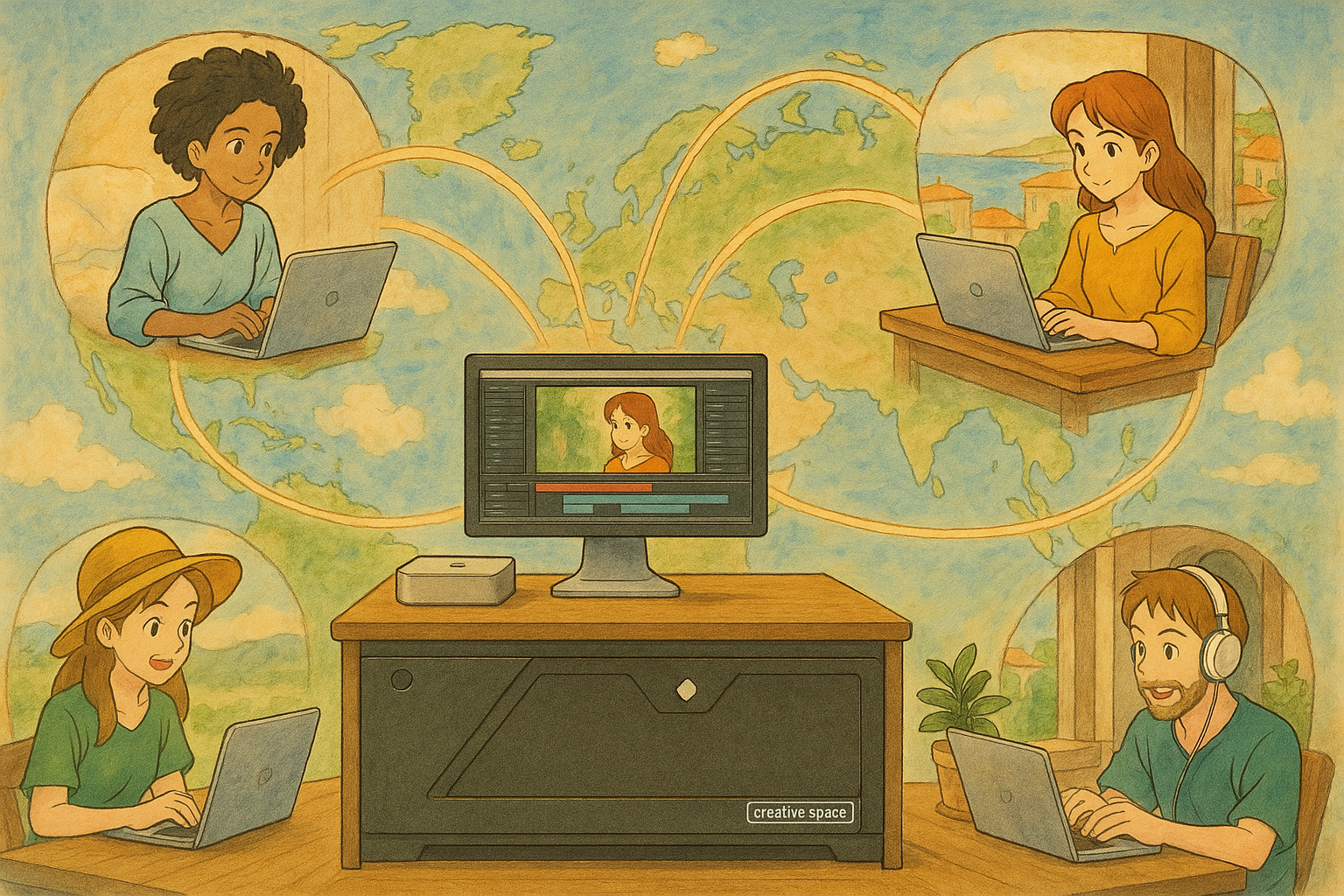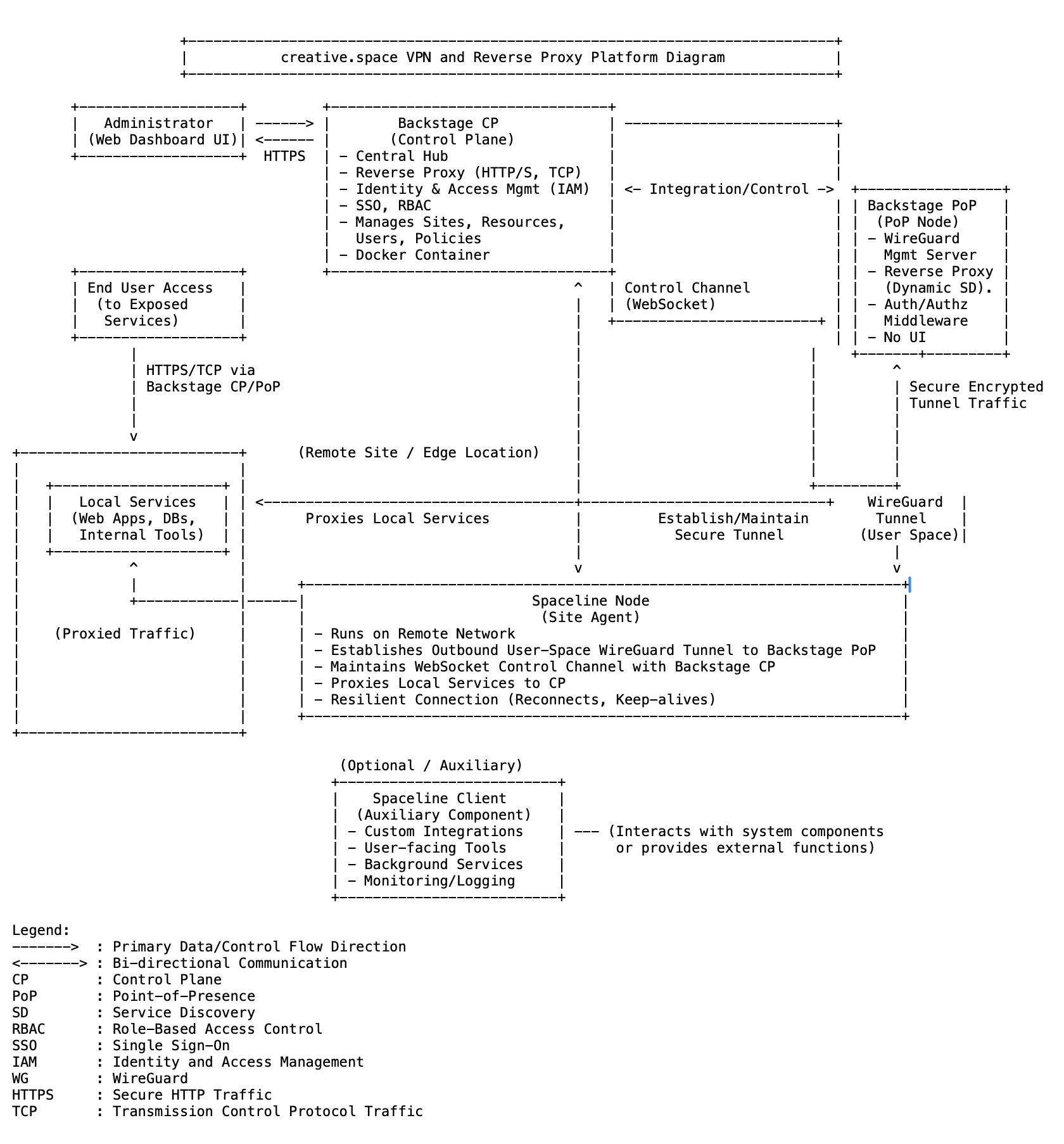
Secure Connectivity Solution for High-Profile Organizations: Protecting Media Assets with creative.space
Learn how creative.space provides a comprehensive VPN and reverse proxy solution to secure sensitive media assets in post-production environments, protecting against unauthorized access and cyber threats.
The High Stakes of Media Security: Challenges in Post-Production
The media and entertainment industry, particularly the post-production phase, operates within a uniquely challenging security environment where digital assets of immense value are constantly targeted. The digitization of intricate workflows and the increasing reliance on remote collaboration have introduced a complex web of vulnerabilities that demand sophisticated security solutions. The fundamental concern is protecting sensitive pre-release content, invaluable intellectual property, and confidential production data from a spectrum of cyber threats, including unauthorized access, malicious theft, and disruptive breaches. The potential ramifications of security failures can be devastating, leading to significant financial losses, the erosion of brand reputation, and legal complications. Simultaneously, the necessity for seamless and secure remote access to these critical assets for geographically dispersed teams and external collaborators adds another layer of complexity to an already intricate security landscape. The convergence of highly valuable digital media, the inherent complexities of distributed workflows, and the ever-evolving sophistication of cyber threats have created a precarious situation for post-production professionals.
Several core security challenges persistently plague the post-production sector. Unauthorized access to high-value assets remains a primary concern. The premature release of pre-release content can severely undermine carefully crafted marketing strategies, negatively impact box office performance, and ultimately diminish overall revenue. The risks emanate from internal sources, such as potentially negligent or malicious insiders, and external threats posed by determined cybercriminals seeking to exploit vulnerabilities. Furthermore, the project-based nature of the entertainment industry, often involving numerous external vendors and temporary team members, makes it particularly challenging to establish and enforce consistent security protocols across all collaborators, increasing the potential for both intentional and unintentional data exposure.
Vulnerabilities inherent in remote access methods also pose significant risks. The practice of directly exposing media server ports to the public internet for facilitating services like FTP and SMB creates readily identifiable targets for malicious actors seeking to exploit known weaknesses in these protocols. Reliance on outdated or unencrypted remote access techniques further exacerbates these risks. The growing trend of using personal devices for remote work introduces additional security complexities, as these endpoints may not adhere to the same stringent security standards as corporate-managed devices. The convenience afforded by traditional remote access methods often comes at a substantial security cost, directly exposing critical infrastructure and sensitive data to potential exploitation.
Finally, the entertainment industry’s high profile and the immense value of its digital assets make it a prime target for sophisticated cyberattacks, frequently resulting in significant data breaches with far-reaching consequences. The theft of intellectual property, encompassing everything from pre-production scripts to final cuts of films and television shows, can lead to substantial financial losses, a diminished competitive edge, and potential legal ramifications. The threat of ransomware attacks, which can effectively lock down critical production systems and demand significant ransom payments, further underscores the precarious security posture of the industry. The concentration of financial and creative capital within media production makes it an attractive target for various cyber threats, from opportunistic attacks to meticulously planned campaigns aimed at stealing valuable intellectual property or disrupting operations for financial gain.
Introducing creative.space: Secure Connectivity for High-Profile Organizations
creative.space represents a comprehensive and meticulously designed VPN and reverse proxy solution specifically tailored to address the intricate security challenges inherent in the media and entertainment industry, particularly within post-production environments. Our solution is engineered to deliver secure and seamless remote access to indispensable media assets while maintaining the highest standards of protection against unauthorized intrusion, data breaches, and a wide array of cyber threats, making it the ideal choice for organizations handling highly sensitive and confidential content. By employing a robust defense-in-depth strategy, creative.space empowers post-production and IT professionals to uphold efficient and collaborative workflows without compromising the paramount security of their valuable media assets.
Encrypted Tunnels, No Exposed Ports: Fortifying Your Media Servers
The direct exposure of ports on media servers to the public internet establishes a significant vulnerability, rendering them susceptible to many cyber threats. Malicious actors can readily scan for these open ports and attempt to exploit known weaknesses in the associated services. This includes employing brute-force attacks to compromise login credentials, launching denial-of-service attacks to disrupt critical operations, and even endeavoring to gain unauthorized access to the underlying server infrastructure. Common functionalities within media servers often necessitate opening ports for essential protocols such as FTP (ports 20 and 21) and SMB (ports 37-139 and 445), inadvertently amplifying the potential for exploitation. Exposing ports directly to the internet is a fundamental security lapse, as it provides a clear and direct pathway for attackers to target specific services and potentially compromise the entire system.
creative.space effectively mitigates this critical security risk by establishing secure, encrypted VPN tunnels utilizing the advanced WireGuard protocol. This eliminates the need to expose media server ports directly to the public internet. All remote access traffic is securely channeled through this robustly encrypted tunnel, rendering the underlying services invisible and inaccessible to direct external attacks. Furthermore, the integrated reverse proxy component acts as a fortified gateway, further obscuring the internal server infrastructure and providing an additional, crucial layer of defense against malicious intrusions.
The Power of WireGuard VPN for Media Workflows
WireGuard, the state-of-the-art VPN protocol that forms the core of creative.space, leverages the User Datagram Protocol (UDP) for data transmission, resulting in significantly faster and more efficient data transfer rates compared to conventional VPN protocols that rely on the Transmission Control Protocol (TCP). This enhanced speed is particularly beneficial for the demanding workflows prevalent in post-production, which often involve the transfer of exceptionally large media files such as high-resolution video and uncompressed audio. UDP’s reduced overhead and streamlined connection establishment process make it ideally suited for latency-sensitive applications like media streaming and the rapid transfer of substantial files. WireGuard’s superior performance, even in challenging network environments characterized by high latency, is a common scenario for geographically dispersed remote teams. WireGuard’s inherent speed and efficiency, particularly through its utilization of UDP, directly translate to tangible improvements in productivity and a significant reduction in the time required to transfer the large media assets characteristic of post-production workflows.
Beyond its speed, WireGuard boasts a suite of robust security features. It employs cutting-edge cryptographic algorithms, including ChaCha20 for symmetric encryption and Curve25519 for elliptic-curve Diffie-Hellman key exchange, ensuring strong encryption and unyielding data confidentiality. Its design philosophy emphasizes simplicity, resulting in a significantly smaller codebase - approximately 4,000 lines of code compared to the much larger codebases of protocols like OpenVPN (around 100,000 lines). This reduced complexity makes it easier for WireGuard to audit for potential security vulnerabilities, thereby minimizing the attack surface. WireGuard’s focus on employing modern, thoroughly vetted cryptographic methods and its inherent resistance to common attack vectors make it a highly secure VPN protocol. The security of WireGuard is fundamentally built upon a foundation of contemporary, efficient cryptography and a design principle that prioritizes simplicity and ease of auditability, culminating in a VPN protocol that is both highly secure and trustworthy.
Furthermore, creative.space, leveraging the power of WireGuard, provides seamless support for essential media production protocols, including SMB and FTP, facilitating secure file sharing and transfer between remote users and centralized media servers. WireGuard can be effectively deployed to secure access to these commonly utilized protocols, eliminating the need for direct and risky port exposure. The compatibility of WireGuard with standard media production protocols ensures that creative.space integrates smoothly with existing technological infrastructure and established workflows, delivering enhanced security without necessitating disruptive changes to current processes.
Granular Access Control: Tailoring Security to Your Needs
creative.space empowers administrators with fine-grained control over access to media servers through several key features. IP-based restrictions allow for the definition of trusted IP addresses or ranges from which users can connect. This adds a critical layer of security by limiting access to only authorized networks or specific geographic locations, thereby further reducing the potential for unauthorized connections. Leveraging the integrated reverse proxy, creative.space also enables URL path control, allowing administrators to restrict access to specific directories or URL paths on the media server. This capability is crucial for ensuring that users only have access to the project files or administrative interfaces relevant to their roles and responsibilities, preventing unauthorized access to sensitive content (inferred from the general functionalities of reverse proxies and the specific security needs of media production). Moreover, creative.space incorporates robust Role-Based Access Control (RBAC) features. This allows administrators to assign users specific roles and associated permissions based on their function within the production workflow. By adhering to the principle of least privilege, RBAC ensures that individuals only have access to the resources and functionalities necessary for their assigned tasks, significantly minimizing the risk of accidental or malicious data exposure. It highlights the importance of role-based access in securing remote access scenarios and emphasizes its role in protecting sensitive post-production data. The strategic combination of IP-based restrictions, URL path control, and granular RBAC provides a comprehensive and multi-layered approach to access control, ensuring that only authorized individuals can access the appropriate resources at the necessary times, thereby significantly strengthening the security of sensitive media content.
Multi-Factor Authentication: Adding Robust Layers of Security
Multi-Factor Authentication (MFA) stands as a cornerstone of modern security practices, requiring users to provide multiple verification factors before access is granted. This significantly reduces the risk of unauthorized access, even in situations where a user’s password may have been compromised. MFA provides a vital second line of defense against prevalent threats such as brute-force attacks and malicious account takeovers31. further emphasizes its critical role in securing remote access to sensitive systems and data. creative.space offers a suite of flexible and user-friendly MFA options to cater to diverse organizational needs and user preferences. These include seamless integration with Single Sign-On (SSO) providers, support for Time-based One-Time Passwords (TOTP) generated by authenticator applications, and the option for email-based One-Time Passwords (OTP). By providing a variety of MFA methods, creative.space ensures that organizations can implement robust authentication measures without imposing undue complexity or inconvenience on their users, thereby promoting wider adoption and a stronger overall security posture.
Secure Architecture: The Tunneled Reverse Proxy Advantage
The fundamental strength of creative.space’s security architecture lies in its implementation of a tunneled reverse proxy. This design ensures that external clients never directly interact with the internal media servers. Instead, all incoming requests are securely routed through the creative.space infrastructure, which acts as a fortified intermediary, significantly minimizing the attack surface and preventing direct access to sensitive backend systems.
Building Trust: Our Commitment to Security
Our commitment to security is deeply embedded in our development philosophy and operational practices. We maintain a publicly accessible SECURITY.md file, providing transparency regarding our security policies and procedures. We actively integrate with CrowdSec, an open-source, collaborative threat intelligence platform, to proactively identify and block malicious IP addresses and emerging attack patterns. This proactive approach ensures continuous validation and improvement of the security posture of creative.space. Our transparent and proactive approach to security, encompassing threat intelligence integration and security audits, demonstrates our unwavering commitment to providing a secure and trustworthy solution for safeguarding our clients’ valuable media assets.
Conclusion
creative.space offers a robust and comprehensive security solution specifically designed to address the unique challenges faced by post-production and IT professionals managing media servers. By leveraging the speed and security of WireGuard VPN, eliminating port exposure through a tunneled reverse proxy, providing granular access controls, and enforcing multi-factor authentication, creative.space delivers a secure and efficient environment for managing and accessing high-value media assets. Our commitment to security is further reinforced through transparent development practices, proactive threat intelligence integration, and regular security assessments, making creative.space the ideal choice for high-profile organizations seeking to protect their valuable media content.


